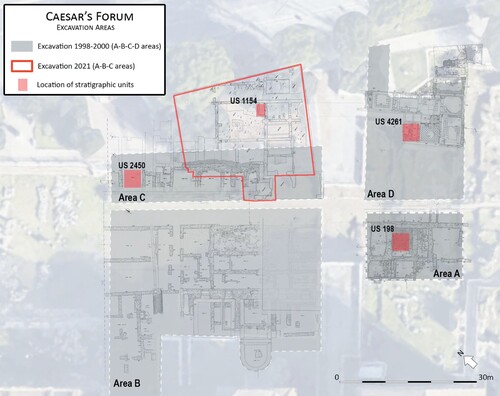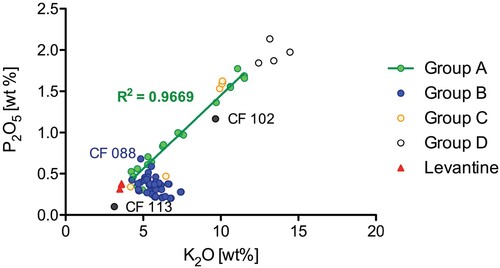ABSTRACT
Italy had a prominent role in the Renaissance European glass market, thanks to three centers of production located in Venice, Tuscany, and Liguria. The substantial amount of glass finds excavated in the 16th-century a.d. dumps of the Forum of Caesar is the object of this first interdisciplinary study of glass from Renaissance Rome. The typology reveals the predominance of medical containers, followed by tableware with parallels in Tuscan productions and a few Venetian-style vessels. The identification of medical vessels confirms the nature of the dump, which formed in connection with a hospital. The trace-element analysis (LA-ICP-MS) distinguishes four different base glasses, of which at least three have a Tuscan provenance. Only one find is Venetian in composition, while the rest of the fine vessels are Tuscan imitations of Venetian styles. The results obtained confirm the literary sources that document the commercial links between Tuscan glass producers and the Pontifical state.
Introduction
During the Renaissance, the Italian peninsula was a key player in the European glass market and in the development of new glass technologies. The Italian glass tradition originated in the 13th century a.d. and revolved around three major centers of production located in Venice, Tuscany (Ciappi et al. Citation1995; Verità and Zecchin Citation2009; Verità and Biron Citation2021) and Liguria (Cagno et al. Citation2012) ().
Figure 1. Map of Italy with sites mentioned in this paper, the Valdelsa (in blue), and the Via Fancigena (in red) indicated. Map: C. Boschetti, adapted from Digital Atlas for Roman and Medieval Civilizations (https://sohp.fas.harvard.edu/digital-atlas-roman-and-medieval-civilizations).
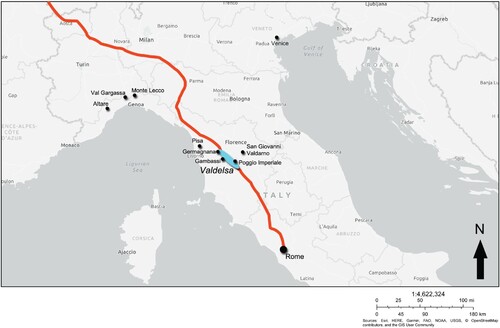
The socio-economic organization of these three centers was profoundly different, which is clearly reflected in the nature of their signature products. At the end of the 12th century a.d., the Republic of Venice developed an innovative system to promote artisanal activities and technical novelties by creating a network of guilds, the Arts, responsible for regulating and verifying the quality of production. The exclusion of merchants from these Arts and artisans from the political administration of the city ensured protection against conflicts of interest (Bottazzi Citation2009; Burkart Citation2021, 65–66). Glass legislation was codified in the Mother Art of Glass and entered in the Mariegole, the books in which all the regulations were published, constantly developed, and improved from the 13th century a.d. until the fall of the Republic (Zecchin Citation1989, 33–75). The Mariegole contained clear instructions on the nature of raw materials and fuels permitted, on the structure of the furnaces, and regulated the activities of the glass workers. The furnaces were managed by glass masters, artisans who obtained the title after an apprenticeship and practical examination, which was assessed by a committee of glass masters and members of the glass guild (Zecchin Citation1989, 108–114). The masters and workers employed at the furnaces were banned from practicing their craft outside the island of Murano (Zecchin Citation1989, 12, 21–23, 43–44). At the same time, commerce of unfinished products such as canes or raw glass was prohibited (Bettoni Citation2017, 81–86). The intention to protect the art of glass becomes increasingly visible in documents from the end of the 15th-century a.d., when the Venetian glass factories operating on the island of Murano became famous for their luxury glasses (Zecchin Citation1989, 44).
The enormous commercial success of Venetian glass is reflected in the spread of Muranese products to European courts and in Islamic countries (Lazar and Willmott Citation2006; Baumgartner Citation2015; Burkart Citation2021, 60–67). Despite the Republic’s efforts to prevent any dispersal of technical know-how, the sources extensively document that the art of Venetian glass spread illegally throughout Italy and Europe (Biron and Verità Citation2012; Lima et al. Citation2012; Baumgartner Citation2015). This phenomenon is at the basis of the birth of several furnaces specializing in the imitation of Venetian luxury products, the so-called glasses à la façon de Venise, which were active in Italian cities and in Europe (Baumgartner Citation2015). The chemical and typological identification of these Venetian-style glasses is very difficult, because the glass masters working outside Venice maintained a high degree of conservativism and used the same recipes and processes as in Venice (Raedt, Janssens, and Veeckman Citation1999; Smit et al. Citation2005).
If the Republic of Venice dominated the market of luxury glass, the Tuscan and Ligurian furnaces traditionally specialized in ordinary tableware and technical vessels, including medical vessels and scientific instruments that supplied pharmacies, hospitals, and alchemic cabinets (Laghi Citation1995a, Citation1995b; Ciappi Citation2008a). The origin of this glass tradition is unclear but is usually attributed to the arrival of glass artisans from Venice or the south of France (Mendera Citation1995). During the 12th century a.d., glass workshops were established in Liguria in the merchant town of Altare, located on the Apennines overlooking Savona (Cagno et al. Citation2012). Glass-making in Altare continued without interruptions until the first half of the 20th-century a.d., and it was also practiced in the hinterland of Genoa between the 13th and 16th century a.d., at Val Gargassa (Quartieri et al. Citation2005), and, from the 14th to the 15th century a.d., at Monte Lecco (Basso, Messiga, and Riccardi Citation2008). In Altare, the glass guild guaranteed the free circulation of artisans, who established workshops in Italy and Europe (Maitte Citation2001).
The first Tuscan glass workshops were established at the end of the 12th century a.d. in Valdelsa (Mendera Citation1995), the valley through which the Italian branch of the Via Francigena passed, one of the busiest roads of the European Middle Ages, bringing pilgrims and trade goods from France, Britain, Flanders, and Germany to Rome (Stopani Citation1998). Interestingly, an early development of glass production from the 13th century a.d. onwards is also documented in Pisa, which controlled the international maritime routes to the region (Redi Citation1994). In the Tuscan cities, the regulation of glass production was even more flexible than in Liguria. In Tuscany the glass artisans did not have their own guild and joined the craft associations connected with the consumption of glass objects or with the infrastructures necessary for their production. For instance, glassmakers were alternatively affiliated with the guilds of pharmacists, chemists, and key makers (Cantini Guidotti Citation1983, 25–29; Ciappi Citation2008a, 47). This free socio-economic organization was reflected in the free movement of Tuscan glass artisans, whose activity spread throughout the region and is documented in Europe and in several Italian cities, including Venice, where they were regularly employed in the glass furnaces (Mendera Citation1995, 32–35). This movement of artisans led to a technical and typological fluidity that resulted in cross-fertilization (Stiaffini Citation1995, 47). For instance, proof of these mutual inspirations is found in the presence of the orinal pisano, a container typically made in Pisa for urine inspections, in the official list of vessels that candidates to the title of master gaffer must be able to successfully blow (Zecchin Citation1989, 111). From the end of the 14th century a.d., the presence of foreigners, including Tuscans, in Murano was in constant decline and explicitly forbidden for much of the 15th-century a.d. (Zecchin Citation1989, 9, 49, 79–90). This change in recruitment patterns follows the rising level of Venetian productions and the consequent increase in counterfeiting attempts throughout the Italian peninsula and Europe (Scuro Citation2021, 107–108). The 16th century a.d. was a period of profound transformation in Tuscan furnaces, in which traditional products were increasingly complemented by fine vessels that imitated Venetian models and also used new recipes (Ciappi Citation2008b).
Exactly where and in what contexts Tuscan, Ligurian, and Venetian glass was distributed in Italy in the 16th century a.d. and, in particular, how Rome was supplied, is still unknown. The only glass-making activity clearly documented in Rome during the Renaissance is a furnace established between the end of the 16th and the beginning of the 17th century a.d. in the Vatican Workshop to produce mosaic tesserae (Belmonte and Salerno Citation2008). The 16th century a.d. sources extensively mention the presence in Rome of bicchierai (from the Italian bicchiere, i.e. beaker) who came from various Italian centers, including Tuscany. It is unclear whether the term refers to glass merchants or glassmakers. The activity of glass furnaces in the papal capital is well established only later, from the beginning of the 17th century a.d. (Vattuone Citation2007).
The glass finds excavated in the dumps of the modern phases of the Crypta Balbi (Cipriano Citation1984), Palazzo Altemps (Ciarrocchi Citation2009), Palazzo della Cancelleria in Piazza Navona (Del Vecchio Citation2009), the convent of Trinità dei Monti (De Santis Citation2009), and the hospital of Santa Maria dei Fornari (De Luca and Ricci Citation2013) are mainly comprised of common glassware, but they have never been analyzed, and they have thus never been attributed to a site of production. In the vicinity of Rome, modern glass was recovered from the Abbey of Farfa, which is an interesting parallel (Newby Citation1991). The identification of a substantial amount of glass finds in the Renaissance phases of the area formerly occupied by the Forum of Caesar offers a unique opportunity to conduct a first comprehensive study of the typology and composition of glass in Rome at the time. The glass finds belong to the Renaissance period of the so-called Alessandrino district that, until the early 1930s, covered the extensive area between Piazza Venezia and the Colosseum in central Rome (Molinari and Spagnoli Citation1990; Meneghini Citation2000; Citation2017, 460–462; Pocino Citation2008; Meneghini and Santangeli Valenzani Citation2010, 141–230; Bernacchio Citation2017; Jacobsen et al. Citation2021a, Citation2021b).
Since the 10th century a.d., the area had largely been abandoned due to the lack of drainage control, but from the second half of the 16th century a.d., it was drained and gradually transformed into a residential district. The Alessandrino quarter underwent rapid development in the following centuries. Early in the 1930s, the district was entirely demolished, and its residents were rehoused on the outskirts of Rome as part of Mussolini’s far-reaching urban redevelopment of central Rome. Via dell’Impero, today Via dei Fori Imperiali, was constructed, and hastily conducted excavations brought to light large parts of the imperial Roman fora. As an outcome of the 1930s’ immense and fast excavations, little is known today about the initial 16th-century a.d. nature of the Alessandrino area (Jacobsen et al. Citation2021a, Citation2021b). The archaeological contexts analyzed here present for the first time a publication of sealed contexts from the 16th-century a.d. phases of the Alessandrino quarter. The primary aim of this paper is to identify the function of the glass vessels from the area of the Forum of Caesar and to investigate their technology and possible origin. The results of the chemical composition analysis are discussed in comparison with published data from contemporary Tuscan and Venetian glass in order to formulate hypotheses about the provenance of these vessels and to open a discussion about glass supply in Rome during the Renaissance.
Archaeological Context of the Glass Finds from the Area of the Forum of Caesar
Within the framework of a new Danish-Italian excavation of the heretofore unexcavated parts of the area known as Caesar’s Forum, a series of archaeological contexts (US 1173, 1183, 1184, and 1197) dated to the second half of the 16th century a.d. were excavated in a vertical sewer (structure US 1154) between May and June 2021 (). These contexts yielded several bronze coins, of which one was minted during the pontificate of pope Leone X (a.d. 1513–1521), and one silver coin issued during the pontificate of pope Giulio III (a.d. 1550–1555). More than 1200 glass fragments were found, together with ceramic plates, so-called majolica dishes, lidded cooking ware (pignatte), and a number of small open vessels with interior glaze used to contain solid and semi-solid medical products. The ceramic and glass finds had been discarded in intact or semi-intact states (). Three of these contexts (1173, 1183, and 1197) contained a large amount of complete ceramic vessels associated with fragmented, but reconstructable, ceramic vessels (). Contexts US 1197 and 1183 were separated by a thin layer of lime, US 1184. Some ceramic fragments from different contexts could be joined together to form complete vessels, indicating that the archaeological material had been deposited in the sewer on one singular occasion. What is more, the dump contained a notable quantity of charcoal. Among the charcoal were fragments of thin-walled and profiled burnt objects still preserving minor parts of their original shape. The dump likewise contained lead clamps commonly used in joints on furniture (SM Figure 1). Although an identification is not straightforward, one hypothesis is that the charcoal and lead clamps could be the remains of wooden trays.
Figure 2. Map with current area of excavation at the Forum of Caesar indicated. Map: Sovrintendenza Capitolina—The Caesar’s Forum Project.
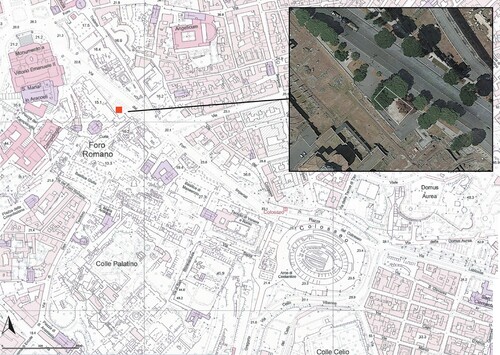
Figure 3. Rim fragment of orinal during excavation. Photo: Sovrintendenza Capitolina—The Caesar’s Forum Project.
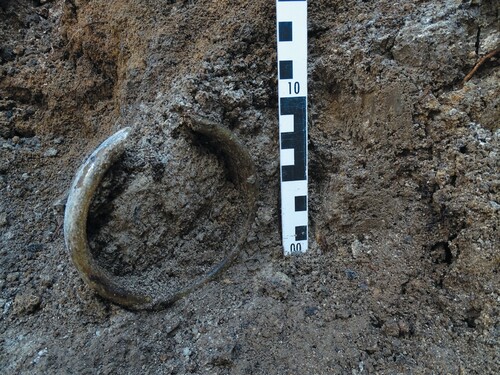
Figure 4. Selection of ceramics from the medical dump excavated in 2021. Photo: Sovrintendenza Capitolina—The Caesar’s Forum Project.
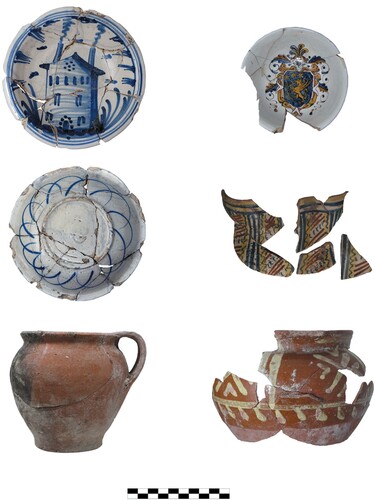
Two further archaeological contexts excavated in the area of the Forum of Caesar in 1999 have similarities with the 2021 dump (for the 1999 excavation, see La Rocca Citation2001; Meneghini Citation2009). US 2450 was the fill of a pit (US 2449) containing ceramics, glass, bones, and a large amount of charcoal. Only a few ceramic finds came to light in the pit, including a complete small medicine vessel and a lid from a pignatta, both similar to the vessels found in the 2021 deposit. The second context, US 4261, was possibly a floor deposit. It contained a complete, small medicine vessel, the joining fragments of a small, white, glazed bowl, and the handle fragment of a second, similar bowl. As stated above the 2021 dump, and, to a lesser degree, also US 2450 and US 4261 from the 1999 excavation (respectively, from areas B and D), shows a clear affinity with hospital activities. Finally, US 198 of the 1999 excavation (area A) contained few fragments of Renaissance glass. This context contained mainly Late Antique materials, and the modern glasses can be considered intrusions which occurred during the 16th century a.d. (). Interestingly, the composition of the assemblage of finds retrieved from these contexts is similar to material accumulations found in relation with Renaissance hospital structures, such as the Hospital of the Congregazione dei Fornari di Santa Maria di Loreto, a professionally-managed hospital established in a.d. 1564 and located in Piazza della Madonna di Loreto, about 325 m from the excavation area (Serlorenzi Citation2010, 151–154; De Luca, Ricci, and Serlorenzi Citation2012; De Luca and Ricci Citation2013).
Materials and Methods
A total of 85 glass fragments excavated from 16th-century a.d. contexts in the Caesar's Forum were analyzed by laser ablation coupled with inductive plasma mass spectrometry (LA-ICP-MS). The selection includes all the diagnostic parts of vessels excavated during the 2021 (n = 63 fragments, distributed as follows: 37 from CF2021 1173, 21 from CF2021 1183, and five from 1197) and 1999 fieldwork campaigns (n = 22, distributed as follows: six from CF99 198, five from CF99 2450, and 11 from CF99 4261). The fragments are colorless or decolorized, with the exception of one translucent turquoise and three bichrome samples that combine decolorized and blue glass. The assemblage comprises a total of 88 points of analysis (SM Table 1). The samples were freshly fractured, embedded in epoxy resin, and prepared in polished sections to be analyzed by LA-ICP-MS at IRAMAT-CEB in Orléans (France). The instrumental setup and analytical protocol followed were described in detail by Gratuze (Citation2016).
Results
Typology and forming technique
The assemblage of glass finds excavated in the 16th-century a.d. deposits of the Forum of Caesar form a coherent group according to their forming techniques and typology (, ). With the exception of three vessels blown in a dip mold, all the other fragments belong to free-blown vessels (see SM Table 1). Renaissance glass vessels are not classified in a proper typological series, but the literature on modern glass from Tuscany, Latium, and Venice is sufficient to identify the shape and, in most cases, the function of the vessels excavated in the Forum of Caesar. The large majority of the fragments belong to vessels that find parallels with the products of the workshops active in Tuscany. The few archaeological studies that have been conducted on the glasses produced in Liguria all focus on indicators of production, and it is not possible to comprehensively identify the typology of vessels manufactured in the region (Bagnasco Citation2021). The vessels excavated in the Forum of Caesar can be divided according to their function into medical vessels, oil lamps, and tableware.
Figure 6. The typology of glass vessels documented in the 16th-century a.d. backfills of the Forum of Caesar: A–C) orinals/lamps, D–E) lamps, F–J) medicine bottles, K–N) beakers, O–R) goblets, S–T) bottles, and U) one unidentified vessel with lathe-cut line under the rim. Image: The Caesar’s Forum Project.
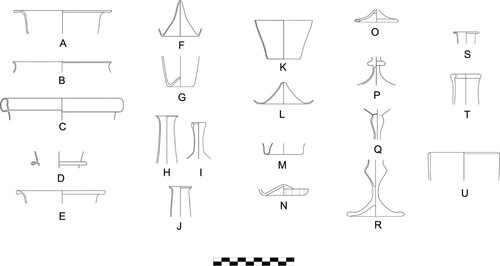
Figure 7. Forming techniques and decorations of the glass vessels from the Forum of Caesar: A–B) applied threads on the external surface of the vessels and C–D) dip-mold blowing. Image: The Caesar’s Forum Project.
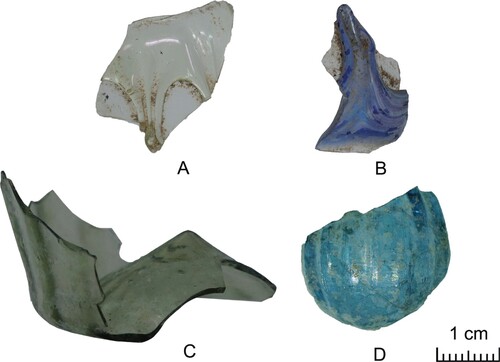
More than half of the glass excavated in the Forum of Caesar can be classified as medical vessels, but the interpretation of some of them is ambiguous. The main group belongs to a class alternatively identified in the literature as medical containers for urine inspections, so-called orinals, or hanging lamps (n = 35) (A, C). These two categories of objects share the same shapes and are commonly published with the two alternative functions. The majority of the orinals/lamps from the forum have straight walls and globular bottoms and, in some cases, a constriction under the rim (see A–B). The lips are outsplayed and cut (n = 30) or outsplayed and folded (n = 5) (see C). In Rome, similar vessels have been found in the 17th-century a.d. dump of the Crypta Balbi (Cipriano Citation1984) and in the 16th-century a.d. dumps of the Hospital of Congregazione dei Fornari (De Luca and Ricci Citation2013), the Palazzo della Cancelleria (Del Vecchio Citation2009), and the convent of Trinità dei Monti (De Santis Citation2009). In Latium, they are documented in the 16th-century a.d. phases of the Abbey of Farfa (Newby Citation1991) and in Viterbo (Stiaffini Citation1999, 122–123). In Tuscany, parallels can be found, for instance, at Lucca and San Giovanni Valdarno (Boldrini and Mendera Citation1994; Ciampoltrini Citation1994). The assemblage is completed by a few examples of vessels that can be clearly identified as lamps (n = 3). Two of them have outsplayed rims and rounded lips formed by a blue thread of glass (E). Parallels are known from the dump of the convent of Trinità dei Monti (De Santis Citation2009) and the Crypta Balbi, such as a colorless lamp with an external crown (Cipriano Citation1984) (D). The bichrome lamps are particularly interesting, because they are perfectly coherent with cesendelli, lamps manufactured in Murano, frequently represented in Venetian paintings of the 16th century a.d. (Barovier Mentasti Citation2006). The lamps from the Forum of Caesar could represent imports from Venice or imitations à la façon de Venise. The medical function is undeniable for a group of small bottles without a foot (n = 19), commonly used to store liquid medicines (Stiaffini Citation1999, 121). This group includes ten fragments of bottoms with pronounced conical kicks and a diameter of approximately 4 cm at the base (F), one bottom with a shallow kick and a diameter of 3 cm (G), and eight necks with cut or rounded lips (H–J). Medicine bottles can be distinguished from tableware by the reduced diameter at the mouth, which measures less than 2.5 cm. These small bottles are documented both at the Palazzo Altemps and the Crypta Balbi (Cipriano Citation1984; Ciarrocchi Citation2009) and are generally attributed to Tuscan workshops supplying pharmacies (Laghi Citation1995a, 104–111; Ciarrocchi Citation2009). The lists of expenses of Renaissance pharmacies show that glass medicine containers were available at a cheap price and were usually used for drugs to be sold to the public (Morozzi Citation1981, 110; Vannini Citation1981, 39, 43–46).
Tableware is represented by beakers, footed cups, and flasks with hemispherical bottoms or bottles, for a total of 25 vessels. In Italy, beakers are the signature drinking vessels of the Medieval period, ubiquitous in the 13th and 14th centuries a.d. The representation of tableware in paintings clearly shows that the beakers were not only used to serve beverages but also to protect the contents of bottles by being used upside-down as covers. In the Forum of Caesar, there are a total of at least 10 fragments that can be identified as cylindrical or truncated conical beakers with shallow conical kicks or convex bottoms (K–M). There are also two ribbed beakers blown in a dip mold (CF 67, 102) (N, C). One fragment of a vessel wall decorated with the application of an irregular network of threads on the exterior can be tentatively attributed to a beaker (CF 136) (A). All these types find parallels in Tuscan contexts of the 16th century a.d. (Boldrini and Mendera Citation1994; Ciampoltrini Citation1994) and, in Rome, in the dump excavated under Palazzo Altemps (Ciarrocchi Citation2009). The mold-blown beakers are an iconic product of the furnaces in Valdelsa and are referred to in the sources as gambassini, which links their origin to Gambassi, one of the villages where Tuscan glass production first developed (Boldrini and Mendera Citation1994). These beakers were produced in several decorative variants and are documented extensively in Tuscany and in several sites in central and northern Italy (Boldrini and Mendera Citation1994; Chinni et al. Citation2021). During the 15th and 16th century a.d., mold-blown beakers were also popular in Murano, where they were probably introduced by Tuscan artisans who had emigrated to Venice (Mendera Citation1995).
From the end of the 15th century a.d., the Italian aristocracy promoted a profound revolution of the dining experience by introducing newly designed tableware that invited guests to express their ability to behave gracefully at the table (Rihouet Citation2013). The most important results of this innovation are the individual sets of cutlery, including forks, and stemmed cups. From the middle of the 16th century a.d., beakers disappeared from aristocratic tables but survived in everyday use and for specific purposes that required more functionality than aesthetics. In the Forum of Caesar, 10 fragments can be firmly assigned to goblets (O–R). The feet are discoidal, with up-folded rims, and the preserved stems are decorated with solid, flattened knots (see P). Two fragments are complete enough to identify the so-called baluster-stemmed cup, a type developed in the middle of the 16th century a.d. (Barovier Mentasti Citation2006; Rihouet Citation2013) (see Q–R). In these cups, the blown balusters of the stems created an elegant formal connection between tableware and architecture. Both the baluster and the knot goblets are well documented in Rome (Cipriano Citation1984; Ciarrocchi Citation2009; De Santis Citation2009; Del Vecchio Citation2009) and Tuscany (Boldrini and Mendera Citation1994; Ciampoltrini Citation1994; Stiaffini Citation1994) during the second half of the 16th century a.d. By this time, stemmed goblets had certainly entered into common use, as can be seen in paintings depicting everyday scenes, such as Annibale Carracci’s The Bean Eater and The Drinker (Barovier Mentasti Citation2006). The tableware assemblage is completed by three fragments of necks with a diameter of more than 3 cm at the mouth, which can be identified with bottles or, alternatively, flasks with hemispherical bottoms (S–T). While bottles are free-standing containers, thanks to the presence of a foot or to the creation of a pushed-in base, the flasks were covered by straw to ensure the stability of the vessel (Boldrini and Mendera Citation1994). These two classes cannot be distinguished when, as in this case, the bottom is not preserved. Bottles with long necks served as wine decanters and were produced both in Venice and in Tuscany, where they were named, respectively, inghistere and guastade (Cantini Guidotti Citation1983, 90). Flasks were used for the retail of wine and were typically produced by the Tuscan furnaces that also provided the straw revetment (Cantini Guidotti Citation1983, 28–29).
Four fragments stand out from the rest of the assemblage, and their identification with a type is problematic. One vessel wall fragment made of colorless glass is decorated with a thick blue thread forming a festoon (CF 71) (B). Similarly applied decorations were common in Venice but also in Tuscany after the introduction of productions à la façon de Venise. The second is a minute fragment belonging to a mold-blown baluster (CF 113) (D). Its transparent turquoise color is typical of the Muranese productions, where similar balusters are documented for stemmed cups, salt cellars (Barovier Mentasti and Tonini Citation2021), and stemmed vases used as reliquaries similar to specimens preserved in the collections of the Corning Museum of Glass (see, for instance, the object 2009.3.94, published in the CMoG online collection database). Two final fragments or rims are perfectly decolored. The walls of these vessels are thick, and one lathe-cut line runs under the lip (CF 94, 101) (U). Their typological identification is problematic, and they might well be identified both with products of the Muranese furnaces or as Tuscan imitations produced in the main town of the region during the second half of the 16th century a.d.
Chemical composition
The full compositional data obtained from the glasses from the Forum of Caesar are presented in Supplemental Material (SM Table 1). The bulk of the Forum samples have elevated magnesium and potassium (> 1.5 wt%) with phosphorous oxides (> 0.2 wt%), reflecting the use of plant ashes as a source of alkalis (Lilyquist and Brill Citation1993), as commonly documented in Europe after the 10th century a.d. (Shortland et al. Citation2006). It has been proven that different plant species produce ashes of variable compositions, which are reflected in the chemical composition of the glass (Occari, Freestone, and Fenwick Citation2021, 3–4, with references). European Renaissance glass productions are generally classified according to the type of plants used (Schalm et al. Citation2007). The furnaces active in continental Europe mainly used the ashes of inland trees and plants, such as birch or fern, which resulted in potash-rich glasses, so-called forest glasses (Kuisma-Kursula, Räisänen, and Matiskainen Citation1997). The Mediterranean region privileged plant species that grow in soda-rich environments and yielded a soda-rich glass, similar to the Islamic glassmaking tradition (Verità Citation2013; Whitehouse Citation2014). Glasses with compositions that lie between the soda-ash and the potash groups, the so-called mixed-alkali glasses, are well documented in continental Europe and may have originated in France, but the routes of diffusion of this technology are unclear (Schalm et al. Citation2007; Janssens et al. Citation2013). The recipes used to obtain mixed-alkali glasses are not well understood, but it is generally assumed that they are a mixture of potash and soda-ash. According to the classification established to distinguish between soda-ash, potash, and mixed-alkali glasses—the latter having Na2O > 6%, and K2O/Na2O > 0.6 (Schalm et al. Citation2007)—the fragments from the Forum of Caesar can be classified as soda-ash (n = 68) and mixed-alkali glasses (n = 20). The magnesium, potassium, and sodium oxide concentrations are consistent with the use of Barilla ash from the western Mediterranean that was obtained by burning plants growing in the coastal regions of Spain, France, and Sicily (Cagno et al. Citation2010) (). Three samples with somewhat lower K2O may have been manufactured with ashes from halophytic plants growing in the Levant (Occari, Freestone, and Fenwick Citation2021). Two samples (CF 102 and 113) are outliers characterized by a lower magnesia content. Sample 113 additionally has a higher sodium concentration, which makes it a Levantine soda-ash glass, while sample 102 is a mixed-alkali glass. The composition of these samples suggests the use of purified plant ashes, a practice introduced around the middle of the 15th century a.d. to improve the purity and clarity of the glass (McCray Citation1998; Verità and Zecchin Citation2009; Verità Citation2013; Verità and Biron Citation2021). The last sample (CF 088) stands out for its lower soda and higher calcium contents.
Figure 8. A) K2O/MgO and B) K2O/Na2O divide the assemblage from the Forum of Caesar, identifying the plant ashes as western Barilla and Levantine. The samples above the line in B) K2O/Na2O can be identified as mixed-alkali glasses. Layout: N. Schibille.
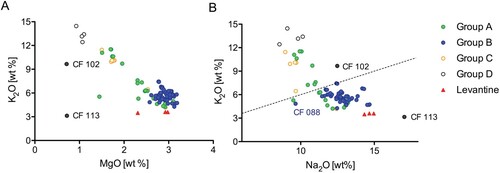
Based on elements reflecting the silica source, such as aluminum, titanium, and iron oxides, it is possible to distinguish four silica sources, one of which may represent the use of quartz pebbles (, Table 1 SM). The first two groups (A and B) share similar TiO2O/Al2O3 ratios, but they differ in terms of Al2O3/SiO2 (). Group A (n = 18) has lower alumina relative to silica concentrations than group B (n = 54). The samples of these two groups are mainly soda-ash glasses with a few mixed-alkali glasses (n = 7 in group A, n = 2 in group B). The three fragments identified as probably manufactured with Levantine ashes cluster together and seem to be affiliated with group A in terms of the silica source (see ). One sample (CF 088) is similar to the glasses of group B but differs in its higher TiO2/Al2O3 and lower Al2O3/SiO2. The silica source underlying group C (n = 8) has even lower Al2O3/SiO2, indicative of a silica source poor in feldspars, while their titanium and iron relative to alumina concentrations are higher. All but one sample of this group are mixed-alkali glasses. A final, small group of samples, with lower TiO2/Al2O3 and Al2O3/SiO2, is likely to represent the use of a quartz-rich silica source, possibly in the form of pebbles (group D, n = 4). Finally, two outliers (102 and 113) differ from the other samples in their lower TiO2/Al2O3 ratios and, in the case of CF 113, in an exceptionally low zirconium content (see Supplemental Material 1).
Figure 9. TiO2/Al2O3 versus Al2O3/SiO2 ratios identify four different silica sources used to manufacture the glass vessels from the Forum of Caesar. Layout: N. Schibille.
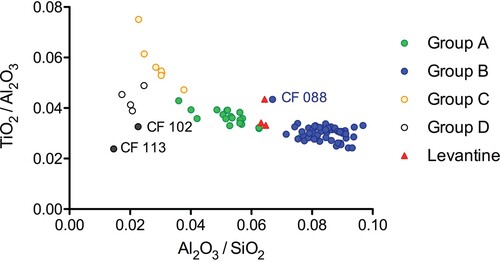
Table 1. Chemical composition expressed in oxides wt% (major and minor elements) of the colorless glasses analyzed for this study, divided by compositional group (with average, standard deviation, and minima and maxima values).
The trace element profile of the glasses from the Forum of Caesar confirms the divisions into groups (). Groups A and B, including the outlier sample CF 088, have the highest levels of trace and rare earth elements and are nearly identical. The samples of group C show a similar pattern but have higher zirconium and hafnium contents relative to the other trace and rare earth elements. The samples of group D have lower concentrations across all trace and rare earth elements, and sample 102 has the same profile. The trace element pattern of sample CF 113 clearly differs and isolates this sample from the rest of the assemblage.
Figure 10. Average concentration of trace elements normalized to the upper continental crust (Kamber, Greig, and Collerson Citation2005) in the four base glass groups A, B, C, and D and in samples CF 102 and CF 113. Layout: N. Schibille.
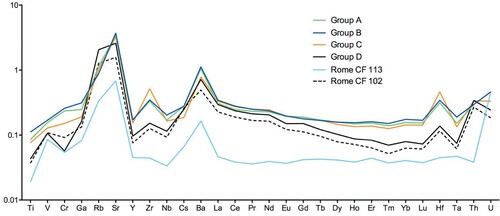
The bulk of the glass analyzed revealed a general trend of increased concentrations of lead, copper, tin, antimony, and cobalt. For copper, lead and tin the levels above 100 ppm can generally be considered as an indication of recycling (Ceglia et al. Citation2019, 286, with previous references) (SM Figure 2). In all the colorless and decolorized samples, the natural color of the glass, due to variable concentrations of iron oxide, was modified by the addition of manganese as a decolorizer. Manganese is present in quantities (0.56 < MnO < 3.28) above the amount naturally contained in soda plant ashes (< 0.06%) (Barkoudah and Henderson Citation2006) and sands used for glassmaking (around 0.02%) (Schibille Citation2022, 33). The positive correlation between manganese and iron (R2 = 0.4921) reflects the empirical processes described in the Venetian and Tuscan glass recipe books, which recommend adding manganese gradually to the molten glass, testing the color repeatedly until the desired effect is achieved (Cantini Guidotti Citation1983, 61–62; Verità and Zecchin Citation2009) (see SM Table 1). Only four samples are deeply colored and transparent. One of them is turquoise, and the others are blue. The turquoise sample CF 113 is colored with a combination of copper and cobalt. The higher arsenic, nickel, bismuth, and uranium of this sample reflects the cobalt raw material extracted in Bohemia and used for glasses, enamels, and glazes starting after a.d. 1530 (Gratuze et al. Citation1996; Biron and Verità Citation2012; Verità and Biron Citation2021). The same cobalt source can be identified in the blue samples CF 71 and CF 97b (group B). Finally, one of the three blue glasses (CF 81, belonging to group D) is colored only by iron oxide.
Discussion
The functional analysis of the vessels from the Forum of Caesar highlights a strong predominance of orinals/lamps and medicine bottles, suggesting that the dump was formed in connection with the hospital located in the nearby Via dei Funari (De Luca and Ricci Citation2013). An interesting parallel in Rome is offered by the 18th-century a.d. dump linked to the Convent of Santa Caterina at the Crypta Balbi (Cipriano Citation1984). This context is rich in residual materials dating from the 15th–17th-century a.d., and orinals/lamps are the most represented category amongst the glass vessels. This pattern of supply very likely reflects the needs of a community rather than that of a private dwelling, in contrast to, for instance, the 16th-century a.d. dumps investigated in San Giovanni Valdarno, where orinals/lamps are rare and tableware prevails (Boldrini and Mendera Citation1994). The typology of the vessels from the Forum of Caesar is perfectly coherent with Tuscan productions of the 16th-century a.d., while only a handful of fragments can be placed in the typology of Venetian glasses and their imitations. Little is known of the typology of vessels manufactured in Renaissance Liguria, but fragments of bottles, goblets, and beakers morphologically similar to the Tuscan products have been found in the Monte Lecco glass workshop (Mannoni and Fossati Citation1975). However, orinals/lamps are not documented among the products manufactured in Liguria.
With the exception of three samples, probably made with Levantine ashes, the glasses from the Forum of Caesar were produced with western ashes. According to the sources, the Tuscan and Ligurian glassmaking furnaces employed local sands and Barilla ashes imported mainly from Sicily, Spain, and Provence and only rarely from the Levant (Stiaffini Citation1995). This is confirmed by the published chemical compositions of Tuscan glasses, where Levantine ashes are only rarely documented (Cagno et al. Citation2010). Interestingly, the use of Levantine ashes is predominant only in the workshop excavated in Pisa (Verità Citation1994). This exception to the Tuscan trend is not entirely surprising, considering that Pisa was a major hub for the import and redistribution of exotic trade goods (Redi Citation1994). The furnaces operating in Venice, on the other hand, used quartz pebbles from the Ticino River, with ashes imported mainly from the Levant and, to a lesser extent, from Egypt (Verità Citation2013). The use of fern and western ashes was expressly forbidden from a.d. 1306 onwards by the Ordnance of the Art of Glass (Zecchin Citation1989, 24), and the published chemical compositions for Renaissance Venetian glasses reveal the exclusive use of ashes imported from the Middle East (Verità, Renier, and Zecchin Citation2002; Biron and Verità Citation2012; Occari, Freestone, and Fenwick Citation2021; Verità and Biron Citation2021).
Comparing our data from the Forum of Caesar with glass from workshops in Tuscany, Pisa, and Valdelsa (Verità Citation1994; Casellato et al. Citation2003; Brianese et al. Citation2005; Cagno et al. Citation2010) and in Liguria (Quartieri et al. Citation2005; Basso, Messiga, and Riccardi Citation2008), their affiliations become clear (). The glasses manufactured in the Valdelsa workshops reflect the use of silica sources with different degrees of purity and are comparable to the majority of the glasses from the Forum of Caesar. In particular, the glass finds from the workshops of Germagnana, Poggio Imperiale, and Gambassi provide parallels for group B. Two sand samples from La Casina, in Gambassi, have a composition consistent with these materials. The glasses manufactured in Pisa are similar but slightly elevated in alumina (Verità Citation1994). Interestingly, the glass samples from the Ligurian workshops of Monte Lecco and Val Gargassa form two well-defined groups that partly overlap with the Tuscan glasses but differ in their lower TiO2/Al2O3 ratios.
Figure 11. Comparison of TiO2/Al2O3 versus Al2O3/SiO2 ratios of published data of glass samples from workshops active in Tuscany and Liguria (Verità Citation1994; Casellato et al. Citation2003; Brianese et al. Citation2005; Quartieri et al. Citation2005; Basso, Messiga, and Riccardi Citation2008; Cagno et al. Citation2010) with the finds from the Forum of Caesar given as 95% Kernel density contours for group A in green, group B in blue, group C in yellow, and group D in grey, using the open access tool: https://c14.arch.ox.ac.uk. Layout: N. Schibille.
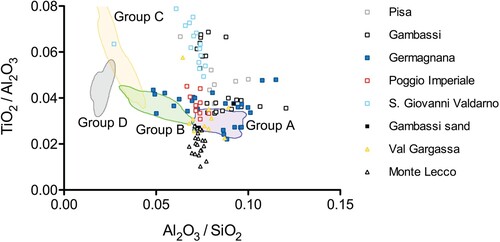
Some of the samples from Germagnana have lower Al2O3/SiO2 ratios and correspond to the samples of group A. Groups A and B include one of the two mold-blown beakers (CF 67) and two of the five Venetian-style vessels (CF 71 and 97), which can now be identified as Venetian-style Tuscan products. This result is not surprising because, in the second half of the 16th century a.d., the production of fine glassware is documented by sources in all main Tuscan towns. The vessels from residences in San Giovanni Valdarno show a greater dispersion, which probably reflects the differences in the chemical composition of the vessels available on the Tuscan market during the 16th century a.d. (Cagno et al. Citation2010). The current understanding of the several furnaces active in Tuscany during the 16th century a.d. is still very fragmentary. The samples of group C find comparisons only in one sample from San Giovanni Valdarno, and it is not possible to establish a clear link with one of the workshops active in Tuscany. However, the close similarity observed between the trace elements of groups A, B, and C supports a Tuscan origin for this group, as well. The predominance of mixed-alkali glasses in the samples of group C could be evidence of their affiliation with a glass producer privileging this technology.
Finally, the vessels of group D remain isolated, but comparison with the chemical composition of Venetian glasses is useful to advance a hypothesis of provenance. Their low Ti (< 0.07 wt %), Zr (< 30 ppm), and Hf (< 2 ppm) is compatible with the compositions of the Venetian glasses manufactured with pebbles from the Ticino River (Smit et al. Citation2005), but their Barilla-mixed alkalis composition does not find parallels in Venice. The Tuscan recipes mention the use of a local raw material, not clearly identified, named tarso, used as a substitute for the Ticino pebbles (Cantini Guidotti Citation1983, 59–60; Ciappi Citation2004, 49). We suggest identifying the glasses of group D with a Tuscan production à la façon de Venise active during the 16th century a.d. A future chemical study of fine glassware from Tuscany could clarify this issue. The blue glass working waste, associated with wasters of fine glassware and blocks of blue glass excavated in Torrino di Montaione, is at the moment the only proof that blue glass and fine glassware was worked in Valdelsa (Ciappi Citation2008a, 44–45).
The only sample that is coherent with the composition of the glasses manufactured in Venice is the fragment of a turquoise baluster stem (CF 113). This sample is in line with the standard composition of the Muranese crystal glass but with a slight excess in potassium oxide. Despite this discrepancy, we tentatively attribute this sample to Murano, taking into consideration that the compositional variations for colored crystal glass is not yet well documented (Verità and Biron Citation2021). Interestingly, the color technology identified in this sample, with the addition of copper and cobalt to a crystal glass decolored with manganese, finds a parallel in the recipe book of the Venetian master Gaspare Brunoro (Moretti, Stefano Salerno, and Tommasi Ferroni Citation2004, 46–47), while in the treatise of the Tuscan Antonio Neri, it is recommended to add copper and cobalt to a non-decolored crystal glass (Neri Citation1980). The practice of recycling, identified by the high levels of contaminants in the samples from the Forum of Caesar (see ) is a further element supporting the Tuscan identification. The addition of glass cullet to the batch is mentioned by the recipe books, and stocks of cullet are regularly listed in the inventories of the Tuscan furnaces (Cantini Guidotti Citation1983, 65–67; Stiaffini Citation1995, 18).
Twenty samples from the Forum of Caesar were identified as mixed-alkali glasses. Mixed-alkali glasses and soda-ash glasses with an increased concentration in potassium oxide are recorded in Venice during the 16th century a.d., and their composition is attributed to the addition of salt of tartar to the soda-ash glass (Verità and Zecchin Citation2009). The salt of tartar was obtained by calcinating, boiling, and repetitively filtering the material deposited at the bottom of wine and vinegar barrels, and the practice of adding tartar to soda glass is well documented by the Venetian glass recipe books (Moretti, Stefano Salerno, and Tommasi Ferroni Citation2004, 25–26; Verità and Zecchin Citation2009, 604). The product obtained after this process of purification is almost pure potash, with traces of iron and alumina (Santopadre and Verità Citation2006, 30). In Tuscany, like in Venice, tartar was commonly used in glassmaking, and it was regularly listed in the inventories of the glass furnaces (Cantini Guidotti Citation1983, 60–62). However, its chemical identification is not straightforward, because the raw materials and the recipes for glassmaking were not strictly controlled. The treatise published in a.d. 1612 by the Florentine abbot Antonio Neri mentions the use of tartar but also a number of plants suitable to obtain good potash-rich ashes. These include cabbage, fava, bramble, and ferns growing in the surroundings of Pisa (Neri Citation1980, 7). Chemical analyses of Tuscan glasses made with potash-rich ashes or with a mix of potash and soda ashes are currently undocumented, but the chemical composition of samples from the Forum of Caesar are useful to reflect on the nature of the sources of alkalis employed. Potassium oxide is positively correlated with phosphorus oxide in all the mixed-alkali and soda samples, with the exception of the soda glasses of group B (). This lack of correlation suggests that, in group B, a certain amount of potash was added in its pure form, most likely as tartar. The strong positive correlation in all the mixed alkali samples suggests that the potassium oxide was not introduced pure but most likely in the form of a mix of soda and potash-rich ashes. The presence of mixed-alkali glasses at the Forum of Caesar could well reflect the different recipes used by the various workshops active in Tuscany during the 16th century a.d., which have not yet been identified archaeologically.
Conclusions
This article provides a first contribution to the study of the provenance of the glass circulating in Rome in the 16th century a.d. The identification of medical vessels and tableware of Tuscan typology and composition confirms the Tuscan hegemony on the Italian market for common and technical glassware. The dump excavated in the Forum of Caesar has a clearly defined medical nature, which is visible in the ceramic finds and confirmed by the function identified for the glasses. The high number of orinals/lamps is consistent with community waste and supports the identification of the analyzed contexts as dumps associated with an organized medical structure, like the nearby Fornari hospital. The presence of a few Venetian-style vessels adds new documentation onto the fine glassware that was available in Rome. The identification of vessels à la façon de Venise with Tuscan composition demonstrates that the imports of Tuscan glass were variegated. This result is coherent with the historical sources that document the activity of a network of Tuscan glass retailers distributed across the peninsula, including Rome (Vattuone Citation2007), during the Renaissance (Cantini Guidotti Citation1983, 166–167). The flow of Tuscan glass to Rome began at least in the 15th century a.d., when the registers of a Florentine glass merchant mention the sale of glass vessels from Valdelsa to the papal court (Cantini Guidotti Citation1983, 175).
Luxury glass is documented at the Forum only by one fragment, identified as a genuine Venetian import. The current state of research is not sufficient to establish if Rome was regularly supplied with Muranese glasses. This fragment cannot be attributed to a precise type, but it is compatible with the lidded reliquaries produced by the Muranese furnaces (Zecchin Citation2019). Interestingly, reliquari de Venetia are listed in the inventories of Tuscan glass retailers, who might have contributed to the distribution of a few specialized Venetian products (Cantini Guidotti Citation1983, 143). The dumps of the Forum of Caesar are not ideal contexts to investigate the circulation of fine glassware, and the commercial dynamics of these productions remain open questions. At present, we can only mention the sources of the second half of the 16th century a.d. that document a continuous flow of luxury products between Rome and Florence (Tonini Citation2011). The letters exchanged between the Cardinal Del Monte, illustrious patron of the arts based in Rome, and the Medicis are particularly informative in this sense (Barocchi Citation1977, figs. 1–5). After a.d. 1569, when the Medicis established their manufacture of crystal glass in Florence, exports of Tuscan glass to Rome started to include these precious crystal vessels. The papal court used these Florentine glasses as diplomatic gifts and requested them in exchange for Roman antiquities excavated in Rome and much desired by the court of the Medicis.
Geolocation Information
41° 53’36’’ N, 12° 29’08’’ E.
Supplemental Material
Download TIFF Image (14.9 MB)Supplemental Material
Download TIFF Image (7.3 MB)Supplemental Material
Download MS Excel (90.3 KB)Disclosure Statement
The authors report there are no competing interests to declare.
Acknowledgments
The Caesar’s Forum Excavation Project is conducted as a collaboration between the Sovrintendenza Capitolina ai Beni Culturali in Rome (concession holder, Claudio Parisi Presicce), the Danish Institute in Rome (DIR), directed by Charlotte Bundgaard from 2019–present, and the Danish National Research Foundation’s Centre of Excellence, Centre for Urban Network Evolutions (UrbNet) at Aarhus University, directed by Rubina Raja. The project has been funded since 2017 by the Carlsberg Foundation (grant held by Marianne Pade, 2017–2021, and Charlotte Bundgaard, 2021–present) and, since 2019, by the Aarhus University Research Foundation through a flagship grant (held by Rubina Raja). Further support comes from the Centre for Urban Network Evolutions under the grant DNRF119. The project is directed by Claudio Parisi Presicce, Jan Kindberg Jacobsen, and Rubina Raja. The open access fee has been paid for by the DNRF grant 119 held by Rubina Raja. All the compositional analyses were performed at IRAMAT-CEB of the Centre national de la recherche scientifique (CNRS, Orléans).
Additional information
Notes on contributors
Cristina Boschetti
Cristina Boschetti (Ph.D. 2009, University of Padua) is a postdoctoral research fellow at the Danish National Research Foundation's Centre of Excellence for Urban Network Evolutions, at, Aarhus University, Denmark. She has previously held postdoctoral positions at the Universities of Nottingham (UK), Padua (IT), and Cairo (Egypt) and at CNRS IRAMAT-CEB, Orléans (FR). She has curated exhibitions on ancient jewelry. Her research interests include glass typology and the application of archaeometric analyses to investigate the economy and technology of glass, jewelry, mosaics, and paintings, with a focus on the period from Hellenism to the Middle Ages and on the development of long-term phenomena.
Jan Kindberg Jacobsen
Jan Kindberg Jacobsen (Ph.D. 2007, University of Groningen) is a curator of ancient art at Ny Carlsberg Glyptotek, Copenhagen, and an associated researcher at the Danish National Research Foundation’s Centre of Excellence for Urban Network Evolutions at Aarhus University, as well as at the Danish Institute in Rome. He directs the Danish research group involved in the excavations at Caesar’s Forum, together with Prof. Dr. Rubina Raja.
Claudio Parisi Presicce
Claudio Parisi Presicce (Ph.D. 1988, Università di Roma “La Sapienza”) is general director of the Sovrintendenza Capitolina ai Beni Culturali, Direzione Musei Archeologici e Storico-Artistici. He is the concession holder of the Caesar’s Forum excavations, which he directs in collaboration with Dr. Jan Kindberg Jacobsen and Prof. Dr. Rubina Raja. He has directed numerous excavations in Rome and curated several special exhibitions at the Musei Capitolini and other museums.
Rubina Raja
Rubina Raja (D.Phil. 2005, University of Oxford) is professor of Classical Archaeology at Aarhus University, Denmark, and center director of the Danish National Research Foundation’s Centre of Excellence for Urban Network Evolutions. She co-directs the Danish-Italian excavations of Caesar’s Forum in Rome together with Dr. Jan Kindberg Jacobsen and Dr. Claudio Parisi Presicce. Her research interests include the Mediterranean from the Hellenistic to the medieval periods, high-definition archaeology, and the intersection between archaeology and natural sciences, iconography, and portrait studies, as well as the history of religion in the Roman world.
Nadine Schibille
Nadine Schibille (Ph.D. 2004, University of Sussex) is a senior research scientist at the Institut de Recherche sur les ArchéoMATériaux (IRAMAT-CEB) of the Centre national de la recherche scientifique (CNRS) in France. She was the P.I. of a recently completed ERC-CoG-2014 project entitled GlassRoutes, and her research interests range from the application of scientific methods to the investigation of ancient vitreous materials and technologies to questions of artistic productions and aesthetics. Her current projects focus on the production and circulation of glass throughout the Mediterranean region during the 1st and early 2nd millennia a.d.
Massimo Vitti
Massimo Vitti (Scuola di Specializzazione 1992, Università di Roma ‘La Sapienza’) is an official at Sovrintendenza Capitolina ai Beni Culturali. He has conducted countless excavations and research activities in Rome, among others at the Palatine Hill, the Imperial Fora, and Trajan’s Markets. Within the Caesar’s Forum Project, he is responsible for the organizational aspects of the excavation, and he is the field supervisor.
References
- Bagnasco, M. 2021. “A New Perspective on Altare.” Journal of Glass Studies 63: 367–71.
- Barkoudah, Y., and J. Henderson. 2006. “Plant Ashes from Syria and the Manufacture of Ancient Glass: Ethnographic and Scientific Aspects.” Journal of Glass Studies 48: 297–321.
- Barocchi, P. 1977. “Presentazione.” In Bichierografia Disiniata Da Giovanni Maggi, Romano Pittore. Libri Quattro, edited by P. Barocchi, 1–14. Firenze: Studio per Edizioni scelte.
- Barovier Mentasti, R. 2006. Trasparenze e Riflessi : Il Vetro Italiano Nella Pittura - OpenBibArt. Verona: Banco popolare di Verona e Novara. http://www.openbibart.fr/item/display/10068/872406.
- Barovier Mentasti, R., and C. Tonini. 2021. “Venetian Glass Saltcellars of the Renaissance.” Journal of Glass Studies 63: 197–246.
- Basso, E., B. Messiga, and M. P. Riccardi. 2008. “Stones from Medieval Glassmaking a Suitable Waste Product for Reconstructing an Early Stage of the Melting Process in the Mt Lecco Glass Factory.” Archaeometry 50 (5): 822–34. https://doi.org/10.1111/j.1475-4754.2007.00375.x.
- Baumgartner, E. 2015. Reflets de Venise : Gläser Des 16. Und 17. Jahrhunderts in Schweizer Sammlungen. Reflets de Venise : Verres Des XVIe et XVIIe Siècles de Collections Suisses. Berne, Romomnt: Peter Lang; Vitrocentre Romont.
- Belmonte, C., and C. S. Salerno. 2008. “Mosaic Glass Made in Rome Between the Sixteenth and Seventeenth Centuries: Rome Glassmakers for the Fabrica Di San Pietro.” Journal of Cultural Heritage 9 (SUPPL.): e93–96. https://doi.org/10.1016/j.culher.2008.06.003.
- Bernacchio, N. 2017. “I Fori Imperiali Nel Rinascimento e Nell’età Moderna.” In I Fori Dopo i Fori. La Vita Quotidiana Nell’Area Dei Fori Imperiali Dopo L’Antichità, edited by N. Bernacchio, and R. Meneghini, 31–48. Rome: Gangemi.
- Bettoni, B. 2017. Perle Di Vetro e Gioie False. Produzioni e Cultura Del Gioiello Non Prezioso Nell’Italia Moderna. Venice: Marsilio.
- Biron, I., and M. Verità. 2012. “Analytical Investigation on Renaissance Venetian Enamelled Glasses from the Louvre Collections.” Journal of Archaeological Science 39 (8): 2706–13. https://doi.org/10.1016/j.jas.2012.03.014.
- Boldrini, E., and M. Mendera. 1994. “Consumo Del Vetro D’Uso Comune a San Giovanni Valdarno (AR) Nel ‘500.” Archeologia Medievale 21: 499–516.
- Bottazzi, M. 2009. “Artigiani? Venezia: L’arte Di Fondere. Dalla Documentazione D’Archivio e Dalle Scritture Incise (Secc. XIII-XVI).” In Formazione Della Ricchezza e Strutture Produttive a Venezia e Nell’area Alpino-Adriatica Fra Due e Cinquecento: Tre Saggi, edited by P. Cammarosano, Bullettino del'Istituto Storico Italiano per il Medio Evo 111: 319–42. Florence: Reti Medievali.
- Brianese, N., U. Casellato, F. Fenzi, S. Sitran, P. A. Vigato, and M. Mendera. 2005. “Medieval and Renaissance Glass Technology in Tuscany. Part 4: The XIVth Sites of Santa Cristina (Gambassi-Firenze) and Poggio Imperiale (Siena).” Journal of Cultural Heritage 6 (3): 213–25. https://doi.org/10.1016/j.culher.2005.03.004.
- Burkart, L. 2021. “Negotiating the Pleasure of Glass : Production, Consumption, and Affective Regimes in Renaissance Venice.” In Materialized Identities in Early Modern Culture, 1450-1750, edited by S. Burghartz, L. Burkart, C. Göttler, and U. Rublack. Amsterdam: Amsterdam University Press.
- Cagno, S., M. Brondi Badano, F. Mathis, D. Strivay, and K. Janssens. 2012. “Study of Medieval Glass Fragments from Savona (Italy) and Their Relation with the Glass Produced in Altare.” Journal of Archaeological Science 39 (7): 2191–97. https://doi.org/10.1016/j.jas.2012.03.013.
- Cagno, S., M. Mendera, T. Jeffries, and K. Janssens. 2010. “Raw Materials for Medieval to Post-Medieval Tuscan Glassmaking: New Insight from LA-ICP-MS Analyses.” Journal of Archaeological Science 37 (12): 3030–36. https://doi.org/10.1016/j.jas.2010.06.030.
- Cantini Guidotti, G. 1983. Tre Inventari Di Bicchierai Toscani Fra Cinque e Seicento. Firenze: Accademia della Crusca.
- Casellato, U., F. Fenzi, P. Guerriero, S. Sitran, P. A. Vigato, U. Russo, M. Galgani, M. Mendera, and A. Manasse. 2003. “Medieval and Renaissance Glass Technology in Valdelsa (Florence). Part 1: Raw Materials, Sands and Non-Vitreous Finds.” Journal of Cultural Heritage 4 (4): 337–53. https://doi.org/10.1016/j.culher.2003.06.003.
- Ceglia, A., P. Cosyns, N. Schibille, and W. Meulebroeck. 2019. “Unravelling Provenance and Recycling of Late Antique Glass from Cyprus with Trace Elements.” Archaeological and Anthropological Sciences 11:279–91. https://doi.org/10.1007/s12520-017-0542-1.
- Chinni, T., S. Fiorentino, A. Silvestri, and M. Vandini. 2021. “Gambassini on the Road. Underpinning Evidence for a Medieval Widespread Glass Production in the North Adriatic Area.” Journal of Archaeological Science: Reports 37: 103039. https://doi.org/10.1016/j.jasrep.2021.103039.
- Ciampoltrini, G. 1994. “La Suppellettile Da Tavola Del Tardo Rinascimento a Lucca. Un Contributo Archeologico.” Archeologia Medievale 21: 555–87.
- Ciappi, S. 2004. “Le Vicende Del Vetro Prodotto in Valdelsa Dal Medioevo All’inizio Del XVIII Secolo. I Dati Forniti Dalla Ricerca Archeologica e Dalle Fonti Documentarie.” Il Vetro a Montaione. Vicende e Personaggi Dal XVIII Al XX Secolo. Firenze: Polistampa.
- Ciappi, S. 2008a. “Maestri Vetrai Valdelsani a Firenze Nel XVI Secolo: Vetri Di Pregio, Da Spezieria e per Uso Alchemico.” In, 43–58. Firenze: Polistampa.
- Ciappi, S. 2008b. “Maestri Vetrai Valdelsani Alla Corte Dei Medici Nel XVII Secolo, Tra Vetri Di Pregio e Strumenti Scientifici.” In Maestri Vetrai Di Montaione : Presenze e Attività Imprenditoriale in Italia Tra XV e XIX Secolo : Note per Un Aggiornamento, edited by S. Ciappi. Firenze: Polistampa.
- Ciappi, S., A. Laghi, M. Mendera, and D. Stiaffini. 1995. Il Vetro in Toscana. Strutture, Prodotti, Immagini (Sec. XIII-XX). Poggibonsi: Lalli Editore.
- Ciarrocchi, B. 2009. “I Vetri Medievali e Rinascimentali Da Palazzo Altemps.” In V Congresso Nazionale Di Archeologia Medievale, edited by G. Volpe, and F. Pasquale, 680–87. Florence: All’insegna del giglio.
- Cipriano, E. 1984. “I Vetri.” In Un “Mondezzaro” Del XVIII Secolo. Lo Scavo Dell’ambiente 63 Del Conservatorio Di S. Caterina Della Rosa (Archeologia Urbana a Roma: Il Progetto Della Crypta Balbi), edited by D. Manacorda, 125–39. Florence: All’insegna del giglio.
- De Luca, I., and M. Ricci. 2013. “Le Ceramiche Dell’Ospedale Dei Fornari.” Bollettino Di Archeologia On Line IV (2–4): 239–48.
- De Luca, I., M. Ricci, and M. Serlorenzi. 2012. “Scavi Metro C Roma Madonna Di Loreto: Ceramiche Dal ‘Butto’ Di Un Ospedale Tra ‘500 e ‘600.” In Atti Del XLIV Convegno Internazionale Della Ceramica 2011, 239–48. Albenga.
- De Santis, F. 2009. “I Materiali Non Ceramici: Vetri, Metalli, Osso.” In Pincio I. La Villa Médicis et Le Couvent de La Trinité-Des-Monts à Rome. Réinvestir Un Site Antique, edited by H. Broise, and V. Jolivet, 267–75. Rome: École Française de Rome.
- Del Vecchio, F. 2009. “Vetri.” In L’Antica Basilica Di San Lorenzo in Damaso. Indagini Archeologiche Nel Palazzo Della Cancelleria (1988-1993) II - I Materiali, 475–80. Roma: De Luca Editori d’Arte.
- Gratuze, B. 2016. “Glass Characterization Using Laser Ablation-Inductively Coupled Plasma-Mass Spectrometry Methods.” In Recent Advances in Laser Ablation ICP-MS for Archaeology, edited by L. Dussubieux, M. Golitko, and M. Gratuze, 179–96. Berlin, Heidelberg: Springer. https://doi.org/10.1007/978-3-662-49894-1_12.
- Gratuze, B., I. Soulier, M. Blet, and L. Vallauri. 1996. “De L’Origine Du Cobalt: Du Verre À La Céramique.” Revue d’Archéometrie 20: 77–94.
- Jacobsen, J. K., G. Murro, C. Parisi Presicce, R. Raja, S. G. Saxkjær, and M. Vitti. 2021a. “High-Definition Urban Narratives from Central Rome: Virtual Reconstructions of the Past and the New Caesar’s Forum Excavations.” Journal of Urban Archaeology 3: 65–86.
- Jacobsen, J. K., G. Murro, C. Parisi Presicce, R. Raja, and S. G. Saxkjær. 2021b. “Practicing Urban Archaeology in a Modern City: The Alessandrino Quarter of Rome.” Journal of Field Archaeology 46 (1): 36–51. https://doi.org/10.1080/00934690.2020.1834255.
- Janssens, K., S. Cagno, I. De Raedt, and P. Degryse. 2013. “Transfer of Glass Manufacturing Technology in the Sixteenth and Seventeenth Centuries from Southern to Northern Europe: Using Trace Element Patterns to Reveal the Spread from Venice via Antwerp to London.” In Modern Methods for Analysing Archaeological and Historical Glass, edited by K. Janssens, 1: 537–62. Oxford, UK: John Wiley & Sons Ltd. https://doi.org/10.1002/9781118314234.ch25.
- Kamber, B. S., A. Greig, and K. D. Collerson. 2005. “A New Estimate for the Composition of Weathered Young Upper Continental Crust from Alluvial Sediments, Queensland, Australia.” Geochimica et Cosmochimica Acta 69 (4): 1041–58. https://doi.org/10.1016/j.gca.2004.08.020.
- Kuisma-Kursula, P., J. Räisänen, and H. Matiskainen. 1997. “Chemical Analyses of European Forest Glass.” Journal of Glass Studies 39: 57–68.
- La Rocca, E. 2001. “Il Foro Di Cesare.” Römische Mitteilungen 108: 174–84.
- Laghi, A. 1995a. “I Vetri Da Farmacia.” In Il Vetro in Toscana. Strutture, Prodotti, Immagini (Sec. XIII-XX), edited by S. Ciappi, A. Laghi, M. Mendera, and D. Stiaffini, 100–113. Poggibonsi: Lalli Editore.
- Laghi, A. 1995b. “La Vetreria D’uso Tra XVI e XVII Secolo.” In Il Vetro in Toscana. Strutture, Prodotti, Immagini (Sec. XIII-XX), edited by S. Ciappi, A. Laghi, Marja Mendera, and D. Stiaffini, 86–100. Poggibonsi: Lalli Editore.
- Lazar, I., and H. Willmott. 2006. The Glass from the Gnalić Wreck. Koper: Univerza na Primorskem, Znanstveno-raziskovalno središče Koper, Inštitut za dediščino Sredozemlja, Koper Project.
- Lilyquist, C., and R. H. Brill. 1993. Studies in Early Egyptian Glass. New York: Metropolitan Museum of Art. https://www.abebooks.com/first-edition/Studies-Early-Egyptian-Glass-Lilyquist-Christine/30188769328/bd.
- Lima, A., T. Medici, A. Pires de Matos, and M. Verità. 2012. “Chemical Analysis of 17th Century Millefiori Glasses Excavated in the Monastery of Sta. Clara-a-Velha, Portugal: Comparison with Venetian and Façon-de-Venise Production.” Journal of Archaeological Science 39 (5): 1238–48. https://doi.org/10.1016/j.jas.2012.01.006.
- Maitte, C. 2001. Corporation et Politique Au Village: Altare Entre Migrations et Différenciation Sociale, XVIe-XIXe Siècle. Revue Historique 617: 47–81. https://doi.org/10.3917/rhis.011.0047.
- Mannoni, T., and S. Fossati. 1975. “Lo Scavo Della Vetreria Medievale Di Monte Lecco.” Archeologia Medievale: Cultura Materiale, Insediamenti, Territorio 2: 31–97.
- McCray, W. P. 1998. “Glassmaking in Renaissance Italy: The Innovation of Venetian Cristallo.” Jom 50 (5): 14–19. https://doi.org/10.1007/s11837-998-0024-0.
- Mendera, M. 1995. “5. I Centri Di Produzione in Toscana. Circolazione Di Maestranze e Di Prodotti Tra i Secoli XIII e XV.” In Il Vetro in Toscana. Strutture, Prodotti, Immagini (Sec. XIII-XX), edited by S. Ciappi, A. Laghi, M. Mendera, and D. Stiaffini, 32–35. Poggibonsi: Lalli Editore.
- Meneghini, R. 2000. “L’Origine Di Un Quartiere Altomedievale Romano Attraverso i Recenti Scavi Del Foro Di Traiano.” In II Congresso Nazionale Di Archeologia Medievale. Pré-Tirages (Brescia, 28 Settembre-1 Ottobre 2000), edited by G. P. Brogiolo. Firenze: All’insegna del giglio.
- Meneghini, R. 2009. Fori Imperiali e Mercati Di Traiano. Storia e Descrizione Dei Monumenti Alla Luce Degli Studi e Degli Scavi Recenti. Roma: Libreria dello Stato.
- Meneghini, R. 2017. “Fori Imperiali e Restauro Gli Interventi Della Sovrintendenza Ai Beni Culturali Di Roma Capitale Nell’Ultimo Decennio (2006-2017).” Atti Della Pontificia Accademia Romana Di Archeologia 89: 429–62.
- Meneghini, R., and R. Santangeli Valenzani. 2010. Scavi Dei Fori Imperiali. Foro Di Augusto (L’Area Centrale) (Bullettino Della Commissione Archeologica Comunale Di Roma. Supplementi 20). Rome: L’Erma di Bretschneider.
- Molinari, M. C., and E. Spagnoli. 1990. “Il Rinvenimento Di via Alessandrina.” Annali Dell’Istituto Italiano Di Numismatica 37: 135–164.
- Moretti, C., C. Stefano Salerno, and S. Tommasi Ferroni, eds. 2004. Ricette Vetrarie Muranesi. Gaspare Brunoro e Il Manoscritto Di Danzica. Firenze: Nardini.
- Morozzi, L. 1981. “La Dotazione Vetraria.” In Una Farmacia Preindustriale in Valdesa : La Spezieria e Lo Spedale Di Santa Fina Nella Città Di San Gimignano, Secc. XIV-XVIII, 107–12. Certaldo: Arti Grafiche Federighi.
- Neri, A. 1980. L’Arte Vetraria 1612, edited by R. Barovier Mentasti. Milano: Edizioni il Polifilo.
- Newby, M. S. 1991. “The Glass from Farfa Abbey: An Interim Report.” Journal of Glass Studies 33: 32–41.
- Occari, V., I. C. Freestone, and C. Fenwick. 2021. “Raw Materials and Technology of Medieval Glass from Venice: The Basilica of SS. Maria e Donato in Murano.” Journal of Archaeological Science: Reports 37: 102981. https://doi.org/10.1016/j.jasrep.2021.102981.
- Pocino, W. 2008. “L’Antiquario Francesco Martinetti e Il Tesoro Di via Alessandrina.” Strenna Dei Romanisti 69: 531–44.
- Quartieri, S., M. P. Riccardi, B. Messiga, and F. Boscherini. 2005. “The Ancient Glass Production of the Medieval Val Gargassa Glasshouse: Fe and Mn XANES Study.” Journal of Non-Crystalline Solids 351 (37–39): 3013–22. https://doi.org/10.1016/j.jnoncrysol.2005.06.046.
- Raedt, I. De, K. Janssens, and J. Veeckman. 1999. “Compositional Distinctions Between 16th Century ‘Façon-de-Venise’ and Venetian Glass Vessels Excavated in Antwerp, Belgium.” Journal of Analytical Atomic Spectrometry 14 (3): 493–98. https://doi.org/10.1039/a808385a.
- Redi, F., ed. 1994. L’Arte Vetraria a Pisa. Dallo Scavo Di Una Vetreria Rinascimentale. Pisa: Pacini editore.
- Rihouet, P. 2013. “Veronese’s Goblets: Glass Design and the Civilizing Process.” Journal of Design History 26 (2): 133–51. https://doi.org/10.1093/jdh/eps056.
- Santopadre, P., and M. Verità. 2006. “A Study of Smalt and Its Conservation Problems in Two Sixteenth-Century Wall Paintings in Rome.” Studies in Conservation 51 (1): 29–40. https://doi.org/10.1179/sic.2006.51.1.29.
- Schalm, O., K. Janssens, H. Wouters, and D. Caluwé. 2007. “Composition of 12-18th Century Window Glass in Belgium: Non-Figurative Windows in Secular Buildings and Stained-Glass Windows in Religious Buildings.” Spectrochimica Acta - Part B Atomic Spectroscopy 62 (6-7 SPEC. ISS.): 663–68. https://doi.org/10.1016/j.sab.2007.03.006.
- Schibille, N. 2022. Islamic Glass in the Making: Chronological and Geographical Dimensions. Leuven: Leuven University Press.
- Scuro, R. 2021. “Shaping Identity Through Glass in Renaissance Venice.” In Materialized Identities in Early Modern Culture, 1450-1750, edited by S. Burghartz, L. Burkart, C. Göttler, and U. Rublack. Amsterdam: Amsterdam University Press.
- Serlorenzi, M. 2010. “Le Testimonianze Medievali Nei Cantieri Di Piazza Venezia.” Archeologia e Infrastrutture. Il Tracciato Fondamentale Della Linea C Della Metropolitana Di Roma : Prime Indagini Archeologiche (Bollettino d’Arte, Volume Speciale), 131–64. https://dialnet.unirioja.es/servlet/articulo?codigo=4839009.
- Shortland, A., L. Schachner, I. Freestone, and M. Tite. 2006. “Natron as a Flux in the Early Vitreous Materials Industry: Sources, Beginnings and Reasons for Decline.” Journal of Archaeological Science 33 (4): 521–30. https://doi.org/10.1016/j.jas.2005.09.011.
- Smit, Z., K. Janssens, E. Bulska, B. Wagner, M. Kos, and I. Lazar. 2005. “Trace Element Fingerprinting of Façon-de-Venise Glass.” Nuclear Instruments and Methods in Physics Research, no. B 239: 94–99.
- Stiaffini, D. 1994. “I Reperti Della Lavorazione Del Vetro. a) La Produzione Del Vetro Di Uso Comune Fra XVI e XVII Dai Reperti Dello Scavo; b) Il Vetro Presso-Fuso.” In L’Arte Vetraria a Pisa. Dallo Scavo Di Una Vetreria Rinascimentale, edited by F. Redi, 69–90. Pisa: Pacini editore.
- Stiaffini, D. 1995. “1. Materie Prime e Combustibile.” In Il Vetro in Toscana. Strutture, Prodotti, Immagini (Sec. XIII-XX), edited by S. Ciappi, S. Laghi, M. Mendera, and D. Stiaffini, 17–20. Poggibonsi: Lalli Editore.
- Stiaffini, D. 1999. Il Vetro Nel Medioevo. Tecniche, Strutture, Manufatti. Roma: Fratelli Palombi Editori.
- Stopani, R. 1998. La Via Francigena : Storia Di Una Strada Medievale. Firenze: Le lettere.
- Tonini, C. 2011. “Vasi in Vetro Verde per La Cappella Paolina in S. Maria Maggiore a Roma: Note Sulla Vetraria Medicea.” Journal of Glass Studies 53: 145–60.
- Vannini, G. 1981. “La Spezieria: Formazione e Dotazione.” In Una Farmacia Preindustriale in Valdesa : La Spezieria e Lo Spedale Di Santa Fina Nella Città Di San Gimignano, Secc. XIV-XVIII, 37–55. Certaldo: Arti Grafiche Federighi.
- Vattuone, L. 2007. “La Universitas Fornaciariorum Fabricatorum Calicum Vitreorum et Crystallorum Ordinariorum: Nuovi e Inediti Documenti per la Storia del Vetro in Roma”. In Atti Delle IX Giornate Nazionali di Studio Il Vetro Nell’Alto Adriatico, Ferrara 13-14 Dicembre 2003, edited by D. Ferrari, and A.Visser Travagli: 148̶–60. Imola-Bologna: La Mandragora.
- Verità, M. 1994. “I Reperti Della Lavorazione Del Vetro. e) Le Analisi Di Laboratorio.” In L’Arte Vetraria a Pisa. Dallo Scavo Di Una Vetreria Rinascimentale, edited by F. Redi, 96–101. Pisa: Pacini editore.
- Verità, M. 2013. “Venetian Soda Glass.” In Modern Methods for Analysing Archaeological and Historical Glass, edited by K. Janssens, 515–36. Oxford, UK: John Wiley & Sons Ltd. https://doi.org/10.1002/9781118314234.ch24.
- Verità, M., and I. Biron. 2021. “Analytical Investigation of Genuine Renaissance Venetian Enameled and Gilded Glass.” Journal of Glass Studies 63: 157–96.
- Verità, M., A. Renier, and S. Zecchin. 2002. “Chemical Analyses of Ancient Glass Findings Excavated in the Venetian Lagoon.” Journal of Cultural Heritage 3 (4): 261–71. https://doi.org/10.1016/S1296-2074(02)01235-9.
- Verità, M., and S. Zecchin. 2009. “Thousand Years of Venetian Glass: The Evolution of Chemical Composiiton from the Origins to the 18th Century.” In Annales Du 17e Congrès de L’Association Internationale Pour L’Histoire Du Verre, Antwerp 2006, edited by K. Janssens, P. Degryse, P. Cosyns, and L. Van’t dack, 602–13. Brussels: UPA (University Press Antwerp).
- Whitehouse, D. 2014. “The ‘Proto-History’ of Venetian Glassmaking.” In Neighbours and Successors of Rome. Traditions of Glass Production and Use in Europe and the Middle East in the Later 1st Millennium AD, edited by D. Keller, J. Price, and C. Jackson, 73–78. Oxford-Philadelpia: Oxbow Books. https://doi.org/10.2307/J.CTVH1DQ24.13.
- Zecchin, L. 1989. Vetro e Vetrai Di Murano. Studi Sulla Storia Del Vetro II. Venice: Arsenale editrice s.r.l.
- Zecchin, P. 2019. “I Reliquiari Dei Vetrai Muranesi Del ‘500.” Journal of Glass Studies 61: 197–208.

